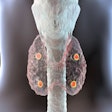
NEW YORK (Reuters Health), Jun 3 - For diagnosing endometrial pathology, hysteroscopy is, not unexpectedly, more accurate than either saline infusion sonohysterography (SIS) or transvaginal ultrasound. But there's still a place for SIS in the workup of women with an intracavitary mass, Greek researchers say.
Dr. Grigoris F. Grimbizis and colleagues from Aristotle University of Thessaloniki performed all three exams in 105 women with menorrhagia, postmenopausal bleeding, or infertility.
In diagnosing any endometrial pathology, hysteroscopy was most accurate (area under the curve [AUC] = 0.953) followed by SIS (AUC = 0.759) and then transvaginal ultrasound (AUC = 0.725), they report in the online May 12 issue of Fertility and Sterility.
For diagnosing endometrial hyperplasia or cancer, hysteroscopy was more accurate (AUC = 0.857) than the other two exams, but not to a statistically significant extent. SIS and transvaginal ultrasound had equivalent -- and poor -- accuracy rates (AUC = 0.632 and 0.615, respectively).
In diagnosing any intracavitary mass -- either endometrial polyps or submucous myomas -- the area under the curve was 0.941 for hysteroscopy, 0.782 for SIS, and 0.612 for transvaginal ultrasound.
Dr. Grimbizis and colleagues say the study highlights the potential role of SIS in routine clinical practice. "Whenever an intracavitary mass is suspected in transvaginal ultrasound, the clinician should complete the work up with SIS," they write. "With this approach, the clinician is assisted in the decision whether to avoid an unnecessary diagnostic hysteroscopy or to be optimally prepared for an advance hysteroscopic procedure."
But Dr. Steven R. Goldstein, professor of obstetrics and gynecology at New York University School of Medicine, told Reuters Health that while SIS is widely available in the United States, he opposes its routine use.
He said the Greek study "misses the mark" because the researchers are trying to use the three techniques to diagnose cancers and hyperplasias. "Cancers and hyperplasias are diagnosed by the pathologist when you give them some tissue, not by ultrasound," he said.
Dr. Goldstein said ultrasound has "very high negative predictive value," confirming a patient "has nothing" anatomically suspicious. "The only people I bring to have a hysteroscopy are people who have proven they have something to remove. And that's what this article and so many other articles miss," he said.
"We should be putting these women into categories to minimize the invasiveness of their treatment yet maximize what we ultimately find out," he said.
By Howard Wolinsky
http://www.fertstert.org/article/S0015-0282(10)00508-X/abstract
Fertil Steril 2010.
Last Updated: 2010-06-02 12:34:05 -0400 (Reuters Health)
Related Reading
Uterine fibroid embolization does not accelerate ovarian reserve decline, January 27, 2010
DNA defect predicts RT outcome for endometrial cancer, January 6, 2010
Copyright © 2010 Reuters Limited. All rights reserved. Republication or redistribution of Reuters content, including by framing or similar means, is expressly prohibited without the prior written consent of Reuters. Reuters shall not be liable for any errors or delays in the content, or for any actions taken in reliance thereon. Reuters and the Reuters sphere logo are registered trademarks and trademarks of the Reuters group of companies around the world.


















